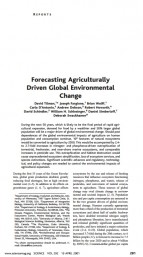
Forecasting Agriculturally Driven Global Environmental Change

During the next 50 years, which is likely to be the final period of rapid agricultural expansion, demand for food by a wealthier and 50% larger global population will be a major driver of global environmental change. Should past dependences of the global environmental impacts of agriculture on human population and consumption continue, 109 hectares of natural ecosystems would be converted to agriculture by 2050. This would be accompanied by 2.4- to 2.7-fold increases in nitrogen- and phosphorus-driven eutrophication of terrestrial, freshwater, and near-shore marine ecosystems, and comparable increases in pesticide use. This eutrophication and habitat destruction would cause unprecedented ecosystem simplification, loss of ecosystem services, and species extinctions. Significant scientific advances and regulatory, technological, and policy changes are needed to control the environmental impacts of agricultural expansion.
- Issues:
- Climate Change, Natural Resources
- Region:
- Global
- Year Published:
- 2001
- Authors:
- David Tilman, Joseph Fargione, Brian Wolff, Carla D’Antonio, Andrew Dobson, Robert Howarth, David Schindler, William H. Schlesinger, Daniel Simberloff, Deborah Swackhamer
- Institution:
- Science Magazine

